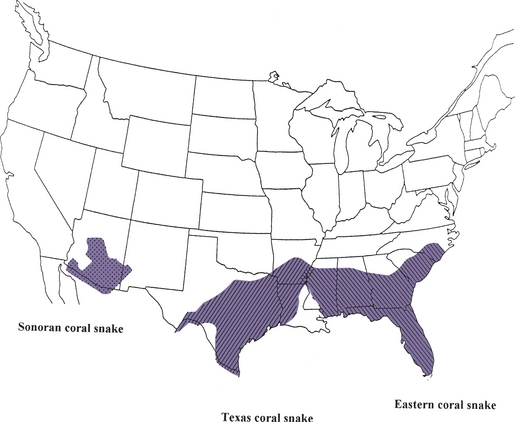Chapter 75 Snake Bite: Coral Snakes
SOURCES
The Texas coral snake has a home range extending from southern Arkansas and Louisiana throughout eastern and West Central Texas. The Eastern coral snake inhabits eastern North Carolina south to Central Florida and west to Alabama, Mississippi, and eastern Louisiana to the Mississippi River. The South Florida coral snake is found in southern Florida and the northern Florida Keys (Figure 75-1).
North American coral snakes are distinctively colored beginning with a black snout and an alternating pattern of black, yellow (occasionally white), and red. They can be differentiated from similar looking nonpoisonous snakes by the coral snake’s color bands, which completely encircle the snake’s body with the yellow band touching the red band. This color pattern can be best remembered by the warning that if caution (yellow) touches danger (red), the snake is a coral snake.
Coral snakes have short fixed front fangs and a poorly developed system for venom delivery, thereby requiring a chewing action to inject the venom. Their pupils are always round; they have no facial “heat sensing” pits, and their heads are not triangular. These snakes are diurnal. Coral snakes are relatively docile, but will respond aggressively if disturbed, delivering a pugnacious bite. In 85% of human bite cases, the snake has to be shaken or pulled off, creating a feeling in the victims reminiscent of separating pieces of Velcro.1 Veterinary patients occasionally are brought in with the snake still attached. Bites by coral snakes are relatively rare. In humans coral snakes account for less than 1% of all venomous snake bites in North America. The majority of coral snake bites occur during the spring and fall.
The Sonoran coral snake (Micruroides euryxanthus) is a small burrowing snake that is relatively innocuous.2 No human fatalities have been ascribed to this snake. There are no reported cases of dog or cat fatalities caused by envenomation by this snake.
TOXIC DOSE
The severity of a coral snake bite is related to the volume of venom injected and the size of the victim. Sixty percent of coral snake bites are nonenvenomating. It is suggested that this is due to a relatively primitive venom delivery apparatus.1 Approximately 4 to 5 mg of venom is a human lethal dose. A large coral snake can deliver a venom volume of up to 20 mg. The length of the snake correlates positively with the snake’s venom yield.3 It is estimated that the human fatality rate caused by coral snake envenomation approaches 10%.4
TOXICOKINETICS
Venom uptake can be delayed for many hours and can take 7 to 14 days to clear the body. One report involving envenomated cats describes clinical improvement by 36 hours, and by 48 hours after the bite, cats were moving their limbs.5
MECHANISM OF TOXICITY
There have been reports of the venom causing hemolysis with severe anemia and marked hemoglobinuria.6 The cause of the red blood cell destruction is poorly understood. It is speculated that it is due to the effects of phospholipase A and its interaction with red blood cell membranes.6
Initial experimental work has indicated that a profound drop in blood pressure occurs if the venom is rapidly absorbed (such as in an intravenous injection). The rapid drop in blood pressure is due to decreases in cardiac output and aortic pressure in response to sequestration of venous return in the hepatosplanchnic bed.7
Other Elapidae venom components, which can cause significant local tissue destruction, include hyaluronidase, proteinase, ribonuclease, desoxyribonuclease, and phosphodiesterase.8
CLINICAL SIGNS
The onset of clinical signs may be delayed for as much as 10 to 18 hours.1,4–6 The mean time from bite to onset of clinical signs in one human report was 170 minutes.1 There are few if any local signs other than the puncture wounds themselves. Occasionally, local pain and regional paresthesia may occur. The victim then begins to have alterations in mental status, and a generalized weakness and muscle fasciculations develop. Progression to paralysis of the limbs and respiratory muscles then follows. These signs are consistent with bulbar dysfunction. The patient is at risk of impending respiratory failure, with pharyngeal spasms, hypersalivation, cyanosis, and trismus (spasms of the masticatory muscles). Aspiration pneumonia is the major complication secondary to marked salivation caused by dysphagia.
Clinical signs of coral snake envenomation reported in dogs are acute central nervous system depression, emesis, excessive salivation, quadriplegia with decreased spinal reflexes in all limbs, and respiratory paralysis. Dogs may exhibit intravascular hemolysis, anemia, hemoglobinuria, and morphological alterations of red blood cells. Also reported in dogs are hypotension and ventricular tachycardia with pulse deficits. Hemolysis has been reported to occur within 72 hours after envenomation.6 Blood-tinged urine and diarrhea may be present.
Clinical signs of coral snake envenomation reported in cats are acute ascending flaccid quadriplegia, central nervous system depression, and reduced nociception. Additionally, anisocoria, absent spinal reflexes in all four limbs, hypothermia, and loss of the cutaneous trunci reflex have been documented.5 Anal tone and micturition are typically normal. In one study examining anesthetized cats given 2 mg/kg body weight of Eastern coral snake (Micrurus fulvius) venom intravascularly; the cats manifested the following signs: drop in blood pressure, respiratory depression 1 hour postinjection, no spontaneous respirations by 3 hours, and an increase in myoglobin release.9 Even at this high intravascular dose, hemoglobinuria was not observed in cats. Hemolysis and hemoglobinuria were not evident in three clinical cases of envenomated cats.5
In humans clinical signs of envenomation by the Sonoran coral snake are much less marked than with Micrurus spp. Clinical signs (e.g., local pain and paresthesia and weakness of the bitten extremity) abated within 24 hours, and the patients were asymptomatic by 4 days after envenomation.10
Stay updated, free articles. Join our Telegram channel

Full access? Get Clinical Tree



